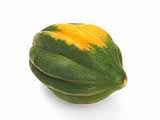 Acorn Squash usually is about the size of a softball, is usually dark green, and has ridges around its surface. Its outside skin is quite hard and inedible. It is the orange meat inside that is delectible.
Acorn Squash usually is about the size of a softball, is usually dark green, and has ridges around its surface. Its outside skin is quite hard and inedible. It is the orange meat inside that is delectible.
Bush vs. Vine - You need to be careful when you are buying acorn squash seed. Most of the varieties are the vining types and can take up to 100 square feet of your garden. The bush type of acorn squash takes up maybe 10 square feet of your garden. So we only offer bush varieties in our seeds section. The planting rules, care techniques, and problems are the same for either the bush type or the vining type.
Planting Acorn Squash
Squash is a tender vegetable. The seeds do not germinate in cold soil, and the seedlings are injured by frost. Therefore in northern states it is best to start seeds indoors about 4 weeks before planting outside which is at least two weeks after last frost. With bush type acorn squash you would want three plants to make up a bush. Harden off by cutting back on water and reducing temperature before transplanting. Do not plant seedlings until all danger of frost is past and soil is thoroughly warmed. Wait until the soil is 60oF to 65 oF before planting.
Disease Prevention - When planting your squash seedlings spray the roots with Actinovate, an organic fungicide. In addition spray the roots with Thrive which will add beneficial fungi and beneficial bacteria that will immediately start working to help and protect that plant.
Harvest should be 85 to 100 days from starting seed. Seed can be saved 6 years.
Caring For Acorn Squash
Ensure Squash Plants Stay Healthy
While proper fertilizing and watering is important to the success of the squash harvest, there are some additional steps you can take that will make an enormous difference in the health of your squash plants. In the first week of every month you should spray your plants with Thrive and Plant Growth Activator. These two products will add beneficial microbes to the leaves of the plant and help fight disease as well as insure that the plant grows to its maximum capability.
Disease Prevention For Acorn Squash
Acorn squash is vulnerable to several fungal diseases such as powdery mildew. Now you can prevent the liklihood of having any disease problems by using a new organic biological fungicide called "Actinovate". When you plant your acorn squash seedlings you spray some actinovate on the roots. Then two weeks later you spray the leaves with Actinovate. Then spray Actinovate monthly through the growing season. You should not have any disease problems.
Fertilizing Acorn Squash
Acorn Squash requires low nitrogen and fairly high potassium and phosphorous for good fruit development. Add an organic granular fertilizer at a rate of 2 to 3 tablespoons per hill of three plants prior to planting. Do not over fertilize with nitrogen as this encourages vine growth and retards fruiting. Bush, dwarf, and short-vined plants do not need as much fertilizer as standard vining types. After the squash plants begin to flower and small fruits form, side-dress with 2 to 3 tablespoons of additional fertilizer. Acorn squash will like a foliar spray of organic fish emulsion once a month through the season.
Watering Acorn Squash
Acorn squash is deeply rooted, so water slowly with 1 inch of water per week. Allow it to completely soak the soil 6-8 inches deep. Water in the morning or early afternoon so the foliage dries by evening. This helps prevent the spread of leaf diseases. Decrease watering later in the season to encourage fruit to mature. At this time, the root systems will be more extensive and able to withstand drier conditions.
Mulching Acorn Squash
As soon as the plants are four or five inches tall apply 2 to 3 inches of organic mulch around each plant.
Harvesting & StoringAcorn Squash
Acorn squash is ready to harvest when a finger nail cannot puncture the outside. It can stay on the vine for several weeks even after it is ripe. Though the vine may not survive the first frost, the fruits can still be harvested. To harvest, the acorn squash can be cut from the vine. Yet it is often easy enough to snap the fruit from the vine. Leave a bit of the stem on the fruit to help preserve moisture. By the time it is harvested there is usually little reason to worry about damaging the vine, as it will soon succumb to winter.
Acorn squash will last several months if stored in a cool dry (but not too dry) place. Cooked acorn squash can be refrigerated for about four days. Once cooked, it may also be frozen for extended periods.
 Cooking Acorn Squash
Cooking Acorn Squash
Acorn Squash can be cut in half and steamed until the meat inside is soft to the fork. Then you have some choices. You can with a large spoon take the meat out of the hard shell and serve it with lots of butter. Or you can add some butter and maple syrup to each half and heat them in the microwave and serve the squash in the shell.

